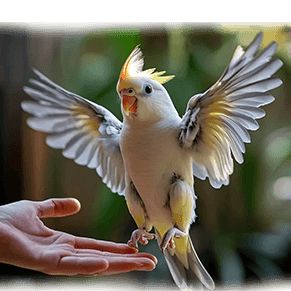How to Train a Budgie: A Comprehensive Guide
Budgies (also known as parakeets) are intelligent and sociable birds, making them highly trainable. Whether you’re looking to teach your budgie to talk, step up on your hand, or do tricks, patience, consistency, and positive reinforcement are key. Here’s how you can successfully train your budgie to become a well-behaved and confident companion.
Step 1: Building Trust

Before any formal training, it’s essential to build trust between you and your budgie. Budgies can be timid at first, and gaining their trust is the foundation of all future training.
- Be patient – Take time to let your budgie get used to your presence. Sit by the cage and speak softly to them daily so they can become familiar with your voice.
- Hand-feeding – Offer treats like millet spray (Amazon affiliate link) from your hand while they are still in the cage. This helps them associate your hand with something positive.
- Avoid sudden movements – Sudden movements or loud noises can frighten budgies. Move calmly and slowly around them.
It might take a few days or even weeks for your budgie to feel comfortable with you, but this is a crucial step before any other training can begin.
Step 2: Training Your Budgie to Step Up
Once your budgie is comfortable with you and your hand, the next step is to teach them to step onto your finger, commonly called the “step-up” command.
- Use a perch or finger (Amazon affiliate link) – Start by gently pressing a perch (or your finger) against your budgie’s chest, just above their legs. This encourages them to step onto it.
- Use a cue word – Say “step up” in a calm voice every time you ask them to step onto your finger or perch. This will help them associate the words with the action.
- Offer a treat – Immediately reward them with a small treat, like a seed or piece of millet, when they step up successfully. Positive reinforcement is key here.
- Practice daily – Consistent practice will help reinforce this behavior, but keep sessions short (5-10 minutes) to avoid overwhelming your budgie.

Step 3: Teaching Your Budgie to Talk
Budgies are known for their ability to mimic sounds and words. Not all budgies will talk, but many can learn with the right approach.
- Start with simple words – Repeat simple words or phrases in a calm, high-pitched tone. Words like “hello” or your budgie’s name are good starting points.
- Use repetition – Budgies learn by repetition, so say the same word or phrase repeatedly. Over time, they’ll start mimicking the sound.
- Incorporate routines – Use the same words at the same time each day, like greeting them in the morning or saying “goodnight” at bedtime. This helps them associate the word with an action or time of day.
- Patience is key – Some budgies may take weeks or months to say their first word, and some may never talk. Patience and consistency are essential in training them to mimic speech.

Step 4: Teaching Your Budgie Tricks
Once your budgie has mastered stepping up and is comfortable with you, you can move on to more advanced tricks. Teaching tricks is a great way to mentally stimulate your bird and strengthen your bond.
- Target training – Start by using a target stick (or any small object like a chopstick). Hold the target in front of your budgie, and when they touch it with their beak, reward them with a treat.
- Roll over – Hold a treat above your budgie’s head and slowly move it in a circular motion. They’ll instinctively follow the treat with their head, causing them to roll over.
- Teach them to wave – When your budgie is perched on your hand, gently lift one of their feet while saying “wave.” Reward them immediately with a treat.
- Short, frequent sessions – As with other training, keep sessions short and positive, and always end on a successful note.
Step 5: Addressing Behavioral Challenges
Sometimes budgies exhibit undesirable behaviors like biting or excessive chirping. These behaviors can be corrected through positive training techniques.
- Biting – If your budgie bites, avoid pulling away quickly, as this reinforces the behavior. Instead, stay calm and gently distract them by offering a toy or treat.
- Excessive chirping – Budgies chirp to communicate, but if it becomes excessive, try providing more toys, mental stimulation, or interaction to curb boredom.
General Training Tips for Budgies
- Positive reinforcement – Always reward good behavior with treats or praise. Budgies respond well to positive reinforcement, and this helps them learn faster. (Amazon affiliate link)
- Consistency – Use the same words, cues, and actions every time you train. This helps your budgie understand what you’re asking.
- Short sessions – Keep training sessions to 10-15 minutes, as budgies have short attention spans. Always end on a positive note.
- Patience – Some budgies may learn quickly, while others take more time. Stay patient and don’t get frustrated if progress seems slow.
- Training books such as “THE ULTIMATE BUDGIE PET HANDBOOK: Complete Guide to Training, Health & Happiness – Learn How to Bond, Communicate & Nurture Your Budgie Companion with Expert Tips on Diet, Taming & End of Life Care” (Amazon affiliate link) by Robert W. Caywood can be a great starting point.

When to Train Your Budgie
The best time to train your budgie is when they are calm and alert. Avoid training sessions when they are tired, stressed, or overly excited. Mornings or early afternoons are typically good times, as budgies tend to be more active during these periods.
Conclusion Training a budgie requires patience, consistency, and a positive approach. Whether you’re teaching basic commands like stepping up, encouraging them to talk, or introducing fun tricks, the key is to build trust and keep training sessions short and enjoyable. Over time, with regular practice, your budgie will become a well-trained and confident companion.
Affiliate Disclosure
This post may contain affiliate links, which means I earn from purchases made through links. Please see the privacy policy page for more details.





